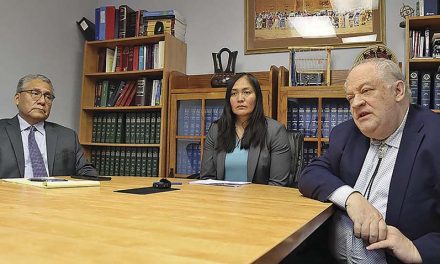
Letters | Environmental injustice: impacts and solutions
Environmental injustice: impacts and solutions
Editor,
What does environmental injustice look like?
On Navajo, it’s marking the 100th Anniversary of the fossil fuel extraction and industry’s reign over tribal resources and a back door to the Navajo Nation Council. Instead of securing a permanent homeland, our reservation was designated as a National Sacrifice Zone by the Federal Government. Decades of extraction of our rich Navajo fossil resources like coal, oil, gas, and uranium, should have made us the richest tribe, yet we remain one of the poorest, as frontline marginalized communities whose lands, air, water, and health, have been sacrificed for unprecedented profits and benefits for elitist, resource colonizers, extractive executives, border towns and mega cities.
The Navajo Nation has fueled and electrified off-reservation cities and towns for over a century and that has helped drive the carbon climate chaos we are in now.
Today, 100 years later, environmental injustices and environmental racism still prevail on Navajo, the latest in the form of the proposed fossil-fueled hydrogen development. Hydrogen, a highly explosive industrial fuel, will be piped through our reservation, again to benefit off-reservation cities and towns, and unprecedented corporate profits for developers. I work for a community-based organization, Tó Nizhóní Ání (TNA). Once we caught wind of the hydrogen bill that was going to be introduced at the New Mexico legislative session in late 2021, we responded with community outreach.
Although all the details of the project itself were still coming through in bits and pieces, we used the science and initiated conversations about what hydrogen is, how it is used and what we knew of the proposed project(s). This educational outreach to chapters using scientific illustrations and Diné interpreters helped lay the foundation for communities to have engaging and meaningful interactions with hydrogen developers because they were aware of not only what the company is trying to sell them but also what concerns they need to be aware of, potential impacts, negative externalities of a hydrogen pipeline, and what a project could mean for their communities. In addition, we developed a resolution, based on the information available, for communities who would like to take an official position on hydrogen and hydrogen development.
The chapters within the pipeline route are Cameron, Coalmine-Canyon, To’Nanees’Dizi, Tonalea, Shonto, Kayenta, Dennehotso, Mexican Water, Sweet Water, Teec Nos Pos, Red Mesa, Gadii’ahi/To’Koi, and Hogback. Out of these 13 chapters, 9 have passed opposing resolutions to hydrogen. The chapters who have yet to take an official position are Cameron, Tonalea, Shonto, and Dennehotso.
There are four (4) main concerns we have identified and emphasized throughout our education. Interestingly, these concerns happen to be issues that the hydrogen developers have avoided addressing in a tangible, sustainable way. These concerns are: 1) Climate change, 2) Water use for hydrogen production, 3) Lack of adequate community engagement, consultation, and consent, and 4) Pipeline safety and encroachment. Because of how energy and water intensive the production of hydrogen is, we have taken the position of opposing all hydrogen development. Crucially, hydrogen development is being proposed in the NW region of New Mexico and will be piped across the North and West parts of the Navajo Nation in Arizona. In short, we don’t want to use any more Navajo water for industry use, we don’t want to prolong the use of fossil fuels like natural gas, or support projects that don’t have sufficient direct community benefits, nor do we want to commit thousands more acres to the pipeline.
A recent study on Blue Hydrogen conducted by the Institute on Energy Economics and Financial Analysis (IEEFA) states that: “1) Contrary to the claims of blue hydrogen proponents, the fuel is not clean or low carbon, and it never will be. 2) … producing blue hydrogen from natural gas is shown to have carbon intensities potentially as high as 5 times the DOE’s clean standard. 3) There is significant risk that the support and funding of blue hydrogen projects will make global warming worse because projects built in the coming years will continue to produce high carbon intensity blue hydrogen for decades. 4) Neither the U.S. Federal Government nor state governments should fund dirty blue hydrogen production projects.” (IEEFA Study, Blue Hydrogen: Not Clean, Not Low-Carbon, Not a Solution; Making Hydrogen From Natural Gas Makes No Sense, 2023).
Our vision for our communities is to be able to take advantage of a Just and Equitable Transition. We would like to see our communities break away from a fossil economy and move to a truly clean, sustainable, and renewable energy economy that is based on principles of climate justice, environmental justice, and Dine’ Fundamental Laws.
The Navajo Nation needs to make the connection that extractive activities won’t sustain our economy, Navajo Generating Station and Peabody was a prime example of that. Even after 50 years of coal extraction, the Navajo economy wasn’t resilient, dynamic, or stable enough to stand on its own, it wasn’t able to absorb all those out of work miners and plant workers. On the flip side, mining permanently altered the host environment and made it harder for the people who still relied on the original Navajo economy (i.e., craftspeople, farmers, pastoralist, artisans) to maintain their livelihoods.
Extractive economies tend to exacerbate pre-existing vulnerabilities in a society, especially in places where governments are unable or unwilling to safeguard their people against severe negative social and environmental externalities. A more recent and abrupt example of this would be the COVID-19 pandemic, where we saw societies with higher vulnerabilities like the Navajo Nation experience higher mortality rates. Extractive economies have a similar outcome, the public usually doesn’t become aware of it because operations like coal mining or hydrogen pipelines last a long time. We don’t realize we are experiencing a slow genocide until it’s too late.
What should environmental justice and climate justice look like on Navajo? We believe it should begin at the grassroots level in community-led movements that seek and support Indigenous traditional values and knowledge that protects and respects our Mother Earth, Father Sky, and all living beings. The shared principles contained in the Dine’ Fundamental Laws should be used as guiding principles to establish a decolonized energy policy that embraces community engagement and community consent-based energy projects that are carbon-free and fossil-free, to create the best pathways for Navajo and our future generations.
Eleanor Smith
Shiprock








 Highway 264,
Highway 264, I-40, WB @ Winslow
I-40, WB @ Winslow